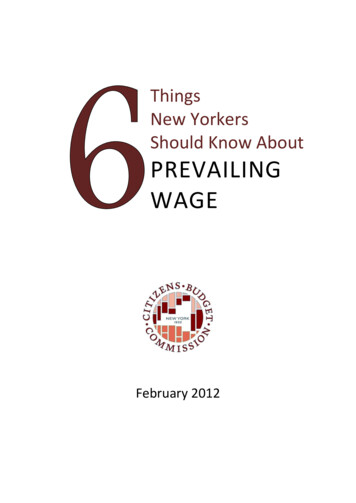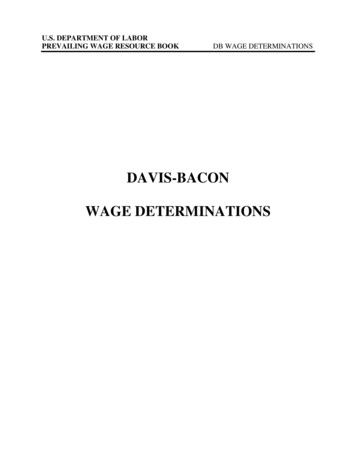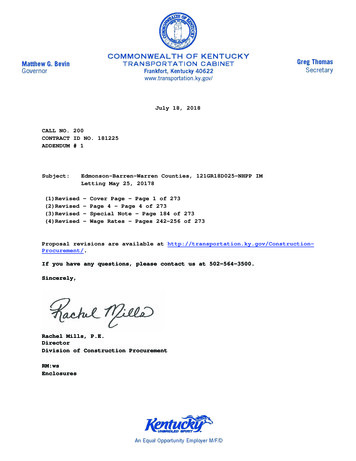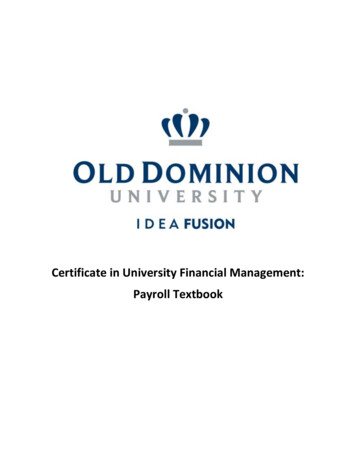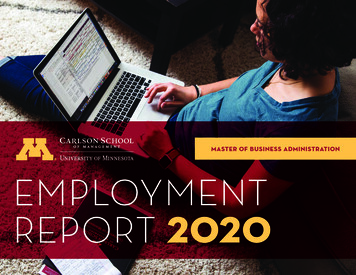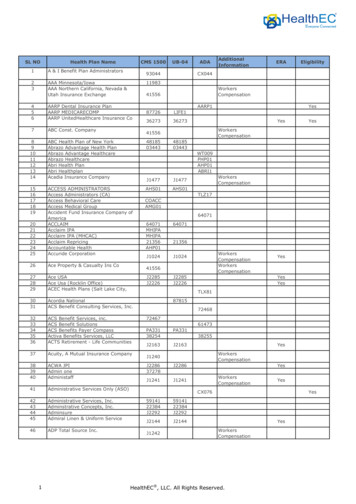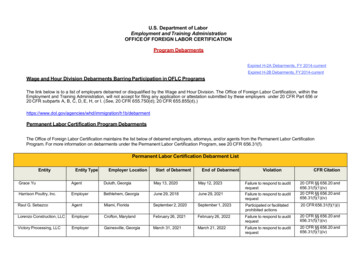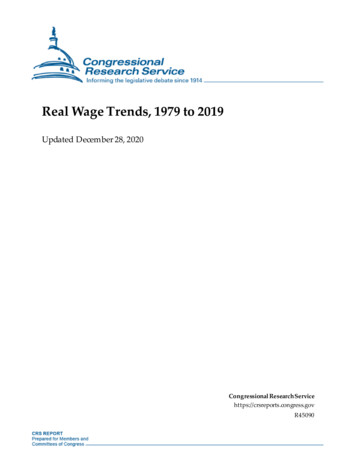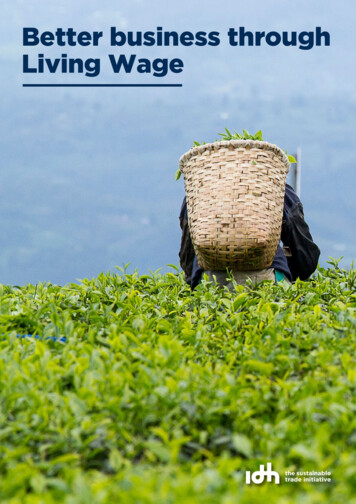
Transcription
Better business throughLiving Wage
Better business throughLiving WageInequality is a growing threat to business and to economicgrowth. According to the OECD, the average income amongthe richest 10 percent of the population is nine times higherthan that of the poorest 10 percent.One way businesses can help mitigate inequality is by payingliving wages to their own employees and by ensuring thatliving wages are paid throughout their supply chains. Earninga living wage means that workers receive sufficient wages tosustain a decent standard of living for themselves and theirfamilies.As we identify best practices through our own work and thework of other companies, we want to share our insights.This publication provides an overview of the five main actionsthat buying companies should consider, including: adoptingbetter procurement and trading practices; embracing transparency; co-investing and implementing practical solutions;supporting social dialogue; and sector-wide collaboration. Weshowcase tools, tips and some examples on how to get startedto implement effective solutions to close living wage gapsin supply chains.Securing a living wage is not just about reducing inequality, itcan also improve business and working conditions. By securinga living wage companies can lower reputational risks, increaseworker productivity and reduce employee turnover1.Investment firms are increasingly incorporating SociallyResponsible Investing (SRI), including supply chainsustainability, into their strategies2. In fact, sustainable equityfunds that emphasize the use of environmental, social, andgovernance criteria to generate financial returns and societalimpact, finished 2020 with a clear performance advantagerelative to traditional equity funds.3The Platform Living Wage Financials (PLWF) is an example ofthis trend. This alliance of 15 financial institutions encouragesand monitors investee companies to address the non-paymentof living wage in global supply chains. As an investor coalitionwith over 2.6 trillion of assets under management, they usetheir influence and leverage to encourage better practices.The public sector has also seen important developments thatcreate an enabling environment for living wages. In early 2021,the governments of Germany and the Netherlands announceda joint effort to work together on the topic of living wages4.At the EU level, legislation on mandatory due diligenceis being discussed.5Over the years, IDH has worked with many partners to improveworking conditions and to close living wage gaps in severalsupply chains, such as tea, bananas and flowers. Based on thiscollective experience, IDH has developed the Roadmap onLiving Wages that outlines the key steps towards a living wage.The roadmap helps companies define a living wage and identify tools that can be used to measure the gap between currentremuneration and a living wage. Once there is clarity on theliving wage gap, companies can implement practical and effective solutions to close gaps in supply chains.1 -pay/2 es/how-sri-builds-sustainable-supply-chains.html3 n-20204 02/Joint Declaration NLD DEU 270121.pdf5 ion-on-mandatory-due-diligence/Better business through Living Wage - 2021
Ready to start working towardsa living wage in your supply chain?Choose the product or sector where you aim to achieve living wages and identifywhere your volumes originate (from which suppliers/countries)1How is the relationship with your supplier?Are they open to discussion and collaboration?There isn’t a direct relationship, or your sourcingvolumes are too small, we suggest aggregating yourbuying power with other buyers to increase leveragewith the supplier.There is a direct, long-term relationship with yoursupplier, and there is openness to collaborate on theliving wage journey.2Inform suppliers of your living wageobjectives and ask them to completethe Salary Matrix. Provide them withthe relevant supporting documentationand background materials.3Once you have the data on the livingwage gap, establish shared frameworkswith the key supply chain partners towork towards closing the gap, withconcrete milestones.Salary matrix and moreHow big are the living wage gaps?Large living wage gapssmall living wage gapsRead moreConsider collaborationRead moreAct by:4Adopting betterprocurement andtrading practicesEmbracingtransparencyCo-developingand implementingpractical solutionsRead moreSupporting socialdialogue andensuring that valuecreated reachesworkersMake itcollaborativeRead moreBetter business through Living Wage - 2021
Adopt better procurementand trading practicesYour company can make a significant change in workers’wellbeing through your decisions on how you source andproduce your products and services. How do you express thevalues of your organization in your contracts and your workwith suppliers? Sustainable practices, including social and environmental factors, should be considered alongside financialfactors when buying/selling/trading products and services.Dialing up a Living WageFairphone designs and produces smartphones with thegoal of improving the electronics supply chain. One oftheir key focus areas is on improved working conditions. As a whole, the electronics industry is knownfor unfavorable working conditions: the well-beingof workers is often not safeguarded, wages are low,and employees are often unable to influence theirwork environment.Why?Confirming the company’s commitment through procurementpolicies on living wage sends a strong signal to internal andexternal stakeholders. Wages are particularly sensitive to thedirect or indirect effects of procurement practices becausethey are variable costs that can be easily affected by competitive pressures. Traditional procurement practices with the aimof maximizing short-term profits, such as electronic biddingand short-term contracting, can pose a threat to living wages.Fairphone supports its direct suppliers to enable themto pay living wages. They estimate the living wage gapwith their suppliers and factor that into what they paytheir suppliers. The fixed living wage bonus of 1.50EUR per phone produced is then incorporated into theproduct price. In a product with a shelf price of 450EUR, the cost of paying a living wage accounts for just0.33%. Each year the size of the bonus is re-evaluatedto integrate new insight gained.Three Actions Encourage demand for living wage products by sendinga strong signal to your suppliers (e.g. through increasedorders to suppliers that pay a living wage) and by buildingawareness among consumers of how they contribute. Support suppliers to pay a living wage to their workersthrough long-term off take agreements, guidance onexpected quality and support to reach it, and financialsupport, if necessary, through higher prices and/or accessto finance for investments required to move towards livingwages. As part of the negotiation process, discuss andagree on how additional value generated is distributedback to workers. Prioritize shorter supply chains and engage in direct andlong-term sourcing relationships. Strong relationshipsbuild trust, which allows you to work together towardslong-term sustainability goals that improve productivityand quality that can support increased wages.Practical Tips The Fairphone bonus is paid on a monthly basis ontop of the regular salary to better accommodate anychanges in the workforce, production line or otherwise.Workers on the Fairphone production line opted toshare the Fairphone bonus among all workers in thefactory. This meant that none of them could achieve aliving wage unless the other buyers from the factoryalso factor in a living wage.6 Build strong relationships with suppliers to implementcost-plus pricing that ensures living wages are factored inwhile enabling the business to remain viable and competitive. Agree on ways to proceed with suppliers, includingan improvement plan with specific milestones to assessprogress and prove the increase of workers’ wages. In lieu of direct supplier relationships, provide traders withdetailed specifications, including transparency and traceability, and requiring the use of the salary matrix. Use yourleverage as a buyer to ensure that the trader implementsthe right sourcing strategy. Engage all relevant departments in your business from thestart: sustainability, procurement, marketing, and sales.Tools IDH Sustainable Procurement Kit. Develop a cost-plus pricing model to understand how living wages can fit in yourbusiness model. Labour Minute Costing Calculators from FairWear. Thistool helps brands and factories to ring-fence the labourcost based on a transparent methodology for costing/pricing of goods. Purchasing Practices Self-Assessment from ACT. Thisonline questionnaire for brands helps assess purchasingpractices, identify change options, and support the movetowards living wages on an industry level.Seven key purchasing practices that impact workingconditions by Better Buying. This buyer rating systemexamines seven key categories of retailer purchasingpractices that affect working conditions for workers.6. 02/016-009 Whitepaper Working Conditions.pdfBetter business through Living Wage - 2021
Embrace transparencyHow well do you know your supply chain? Transparencyrequires an in-depth understanding of what is happening inyour supply chain, both up and downstream and sharing thatknowledge internally and externally.Dutch Retailers’ Commitment onLiving Wage BananasDutch retailers have committed to work with IDH, theSustainable Trade Initiative, on a five-year living wageinitiative in the banana sector.Why?Transparency improves the efficacy of the due diligence process and is valued by financial institutions, rating agencies andconsumers alike. It enhances business reputation by demonstrating a business’ commitment to making steady progresson living wages.Dutch supermarkets Albert Heijn, Boni, Boon, Coop,Deen, Hoogvliet, Jan Linders, Jumbo, Plus, Poiesz, Sligro, Spar, Superunie, Vomar, and the Dutch Food RetailAssociation (CBL) agreed to work towards living wagesfor banana workers in their international supply chains.Participating retailers are committed to increasing theavailability of bananas produced by workers earninga living wage.Three Actions Make purchases contingent on traceability and transparency. A sourcing commitment can help build trust withsuppliers who share similar values on closing living wagegaps. Remember that transparency is a two-way street andproviding information to your suppliers is best practice.During the first phase, the private sector partiesinvolved (producers, suppliers and retailers) developinsights into the gap between current wages andliving wage benchmarks (i.e., the living wage gap).IDH’s Salary Matrix tool is used to achieve this objective.Make public commitments to close living wage gaps.Establish concrete milestones, and a commitment tomeasure progress over time. Ensure that your supply chainpartners, both up and downstream, have a similar commitment to sharing information. This includes identifying andmonitoring the living wage gap through the Salary Matrix.In the first phase, 117 farms from five countries submitted their information on the Salary Matrix. These farmsproduce a total of 830.943 metric tons of bananas fortheir entire customer base. In total, Dutch retailers inthe program purchase 7,6% of all bananas produced bythe reporting farms. These farms represent 42% of thebananas purchased by participating retailers in 2019.Report publicly on your progress. Transparency aboutthe living wage gaps and their root causes demonstratesaccountability and is key to enabling clear dialoguefor progress.With the living wage gap for this portion of the bananasupply chain determined, the group will take severalsteps, including rollout of the Salary Matrix to cover100% of the banana assortment sold in the Dutch market, and further cooperation among retailers and supplychain partners to identify root causes and solutions toclose the living wage gaps.Tools Find a relevant living wage benchmark IDH’s benchmark finder tool can help you find living wagebenchmarks based on recognized methodologies. Monitor wages in the supply chain – The IDH Salary Matrixprovides important information that can be used to monitor progress on wages. The Salary Matrix includes detailedinformation on defining a living wage, and how they aremeasured and verified. IDH audit guidelines and training for auditors. You canverify progress through auditing schemes that have embraced living wages and are using the Salary Matrix.Practical Tips Data verification through auditing ensures credibility. Share learnings on your journey to closing living wagegaps; this will demonstrate your progress and bring credibility to your endeavor.Better business through Living Wage - 2021
Co-invest and implementpractical solutionsRemoving barriers and closing the living wage gaprequires coordination and action among the relevantsupply chain players.Why?Low wages reflect the variety of challenges at the supplierlevel, often related to low productivity, quality and prices, orlimited workers’ skills and social dialogue. Efforts to achieveliving wages need to address these issues while supporting thelong-term sustainability of the sector.Three Actions Engage in dialogue with suppliers, producers, and otherrelevant local players (unions, workers’ representatives,government agencies, etc.), as well as other international buyers when needed, to find solutions for closing theEosta’s sells the first Living WagemangoesEosta, an international distributor of organic fruitsand vegetables, has implemented several projects toimprove social conditions in their supply chain. Eosta isthe first supplier to bring Living Wage products to storeshelves in Europe with their Living Wage Mangoes.Research by their mango supplier, Fruiteq, inBurkina Faso found that closing the Living Wage gapfor all warehouse workers and harvesters wouldrequire an additional charge of approximately 0.10per kilo of mangoes.Eosta has sold more than 100 tonnes of organic Livingwage gap over time.Wage mangoes, equivalent to five full containers. Support suppliers to pay a living wage to their workers byco-investing on supplier activities that can create highervalue that leads to higher wages. This includes supportingsuppliers to increase farm efficiency by enhancing qualityand/or productivity, reducing post-harvest losses, facilitating access to finance, and providing training that supportsfactory goals around productivity and profitability.To ensure that the value generated is distributed toworkers, a fund was created in consultation with workers to offer interest-free microcredits. Money collectedthrough the living wage surcharge is added to this fundand used as a rotating fund to create a sustainablecatalyst for helping more people. Ensure that any value created is distributed to workers inthe form of higher wages.Practical Tips Ensuring that any value created reaches workers can bea challenge. Monitoring in a timely manner is essential toinform strategy decisions. The challenges can also comefrom outside the supply chain. For example, a rise in cashwage could lead to higher income taxation or to a rise inrents of workers’ houses, which doesn’t translate to anincrease in workers’ take home pay. Start by engaging in ‘’quick wins’’ that can be quickly implemented to demonstrate progress while building cooperation and confidence. For instance, workers’ remuneration can be increased by providing more and better in-kindbenefits, such as meals at work, housing, transportation,childcare, children’s education, and medical care. Engage a knowledgeable and neutral actor tofacilitate dialogue and the creation of common actionplans when needed. Develop reasonable solutions to increase wages that donot involve more hours of work. Wages earned throughovertime work are not considered in the calculation of aliving wage.Better business through Living Wage - 2021
Support social dialogueDialogue is critical to labour rights, facilitating wage determination, improving working conditions and promoting sustainable businesses. The process of employers, workers and theirrepresentatives discussing the conditions of work is referredto as social dialogue.Race to the Top in the apparel sectorWhat if the apparel sector’s race to the bottom of pricingand manufacturing standards could turn into a race tothe top? With this in mind, the Race to the Top initiativewas launched to promote and integrate sustainablemanufacturing practices and better working conditions inthe Vietnamese apparel and footwear sector.Why?For a living wage approach to be effective and sustainable overtime, wage-setting must be locally-owned. This means promoting and requiring respect for the freedom of association,collective bargaining, and social dialogue at the workplace.This ensures that any value created through the adoption ofsustainable practices or co-investments with supply chainpartners passes on to workers in the form of higher wages.Local ownership is also important for ensuring good health andsafety conditions at the workplace.The program’s partners included brands and technicalexperts, such as GAP, Levi’s, USAID – United StatesAgency for International Development, Better Work, andthe Sustainable Apparel Coalition. Through the facilitationof IDH, they developed a program to support factories byproviding training and setting up systems for structuralworker-management engagement.Based on the training, a collaboration process calledImprovement Circles (ICs) was developed andembedded within the factories’ structures. ICs providea space for workers and managers to discuss and solveworkplace-related problems and find opportunities forbetter collaboration and productivity. The training formanagement, supervisors, and workers helps develop softskills, builds trust, and teaches dialogue skills to engageon improvements. This results in more productive factoriesthat provide better working conditions with higher jobsatisfaction and fewer unresolved grievances, and createsa win-win for all.Three Actions Respect the fundamental rights of freedom of association and collective bargaining. Locally-owned wage-setting mechanisms such as collective bargaining, provide theoptimal model for both employers and workers to find awage that accommodates the interests and needs of business and labour. Commit to working with suppliers whorespect these basic rights. Support training for management and workers to havethe capacity and knowledge to engage in effectivesocial dialogue. Advocate for fundamental principles and rights at work,especially in countries you source from that have notratified ILO fundamental conventions. Most importantly:freedom of association and the effective recognition of theright to collective bargaining; the elimination of all formsof forced or compulsory labour; the effective abolitionof child labour; and the elimination of discrimination inrespect of employment and occupation.The factories that concluded the Race to the Top’s WorkerEngagement program all showed improved productivity,worker well-being and satisfaction. Reduced absence andturnover confirm this trend. Years after the conclusion ofthe final trainings from the first factories that joined,over 85% of workers still use the Improvement Circleinstalled in the factory to resolve issues and discussimprovement opportunities.At this moment, IDH is working with CNV internationaland the The Vietnam General Confederation of Labour(VGCL) to roll-out additional support to the textile sectorand other manufacturing & food-processing sectors inVietnam, regarding multi-company collective bargaining.Tools ation from FairWear. These targeted on-site trainingeducates both workers and management on the eightFair Wear labour standards and teach effective methodsfor communicating problems and resolving disputes bygetting to the root of the owth The-Business-Case-for-Social-Dialogue.pdf. This brief from ILO andOECD demonstrates the business case and provides achecklist for effective social dialogue.Practical Tips To achieve effective workers representation, capacity-building may be needed. Local unions can receive assistance from international unions such as IUF, FNV, CNV,among others. Social dialogue processes can be informal or institutional.Opening clear dialogue among management and workerscan begin informally and progress to a formal regional,national or enterprise level. Social dialogue can contribute to improved businessperformance, productivity gains and enable innovation.Better business through Living Wage - 2021
Make it collaborativeMore often than not, no single actor can guarantee a livingwage alone. Removing barriers and closing wage gaps on awider level requires collaboration and commitment amongtraders, retailers, brands, suppliers, social partners, civil society and national governments.Tools Download Collaborative Transformation, a book that documents the collective knowledge of IDH and our partners, accumulated over the last 10 years, as we worked to acceleratethe adoption of sustainable practices in international trade.Why?Practical TipsWages that are far below a living wage are often a symptomof deeper challenges that threaten the viability of the industry,and possibly even the national economy. In these cases,the long-term future of the sector requires a holistic, sectorwide response. Work broadly across your supply chain. When you focuson a single origin, it can affect the competitiveness ofproducers and limit progress. A thorough analysis of the sector is often required andmost likely a range of interventions will need to bedeployed to close the living wage gap. An accountability mechanism should be agreed upon tohold partners to account on their commitments to theaction plan. The living wage progress should be measuredand made public on an annual basis including a reflectionon the macro economic developments for the region,including inflation, exchange rate developments and pricedevelopments in the sector targeted. When national minimum wages are set too low, the mosteffective way of advancing the interests of workers isto join other companies, trade unions and partners toencourage national governments to lobby for higherwages or better minimum wage-setting machinery.Three Actions Establish shared commitments with supply chain actors,with concrete milestones. Start or take part in multi-stakeholder initiatives (MSI),with the support of a neutral convenor that can facilitatethe dialogue between the different supply chain actorswhich often will have contrasting viewpoints and variedinterests. Under the MSI, define an action plan that is formulated together with local stakeholders with clear leadsfor the implementation for the different activities defined. Document and share learnings, progress, challenges andsolutions to inform the joint effort in a collaborative manner.An unprecedented collaboration:Malawi Tea 2020developed and several global tea buyers adopted the model to informMalawi Tea 2020 was developed as a joint effort to revitalize the MalawianProgram achievements included: The first Collective bargaining agreement between the PlantationAgricultural Workers Union (PAWU) and the Tea Association ofMalawi (TAML). A significant narrowing of the living wage gap, from approx. 70% atthe outset, to 33% in 5 years. Coalition buyers sourcing 66% more tea volume from Malawi sincethe start of the program. Influencing Malawi government to raise the income taxation threshold to increase take home pay of tea workers. For more ments/tea industry and improve the lives of its workers and farmers. It was oneof the first country-level initiatives aimed at securing a living wage.In a true collaborative effort with stakeholders from across the entire teasupply chain, the 36 partners signed an MOU commitment, developed aroadmap for Malawi Tea 2020, and agreed on a five-year timeline to closethe living wage gap.The Roadmap was developed and agreed among local stakeholders,and actions were spread across five pillars. The partnership establisheda Steering Committee, chaired by IDH as a neutral party, and designatedpillar leads who would report, reflect and agree on actions within andacross the different pillars. On an annual basis, an independent WageCommittee, led by Richard and Martha Anker, provided a report on livingwage progress made and a reflection on the macro economic developments in the country and in the sector, including inflation rates, incometaxation, exchange rate and tea price developments.The Roadmap included actions for revitalizing the Malawi tea sector toensure a higher quality product that would attract a higher price in themarket. It also included support for the social dialogue process, whichwas not formalized at the start of the program. Furthermore, actions weretaken to improve the in-kind benefits for tea workers, including improvement of midday meals, better HR and gender policies, and improvementsin quality of housing. In addition, a sustainable procurement model wastheir procurement decision making.Many lessons have emerged from the program, including the challengeof global market economics where too much focus on a single origin candistort its competitive advantage. Strong supply chain commitmentto suppliers is essential when or if market demand shifts due to higherwage commitments.Another important insight is to carefully evaluate how value generatedin a living wage program actually improves the lives of workers. In theMalawi example, higher cash wages led to workers having to pay more income taxes. When this came to light, the stakeholders influenced Malawigovernment to take action. The government raised the threshold, whichincreased workers’ take home pay.Other reflections from the Malawi Tea 2020 program can be found here:https://www.malawitea2020.com/reflections/
Shared responsibilityConclusionCompanies have the power to be a driving force in assuringliving wages throughout supply chains. Throughout this paper,we have provided an overview of the actions that companiesshould consider for closing wage gaps in the supply chain,including tools, tips and examples of how to get started.Our vision is a world where workers are valued and living wages are an integral part of a sustainable, resilient business. Webelieve that the living wage journey is a critical investment inthe future of business.It is important to note that no single actor can achieve a livingwage for all workers in international supply chains. The livingwage journey is a responsibility that must be shared amongcompanies, governments, civil society, trade unions, investorsand consumers.Collaboration and shared responsibility is key to creating anenabling environment for living wages. Other actions thatshould be considered by all stakeholders include: Creating public and credible tools to establish living wages benchmarks across the world and to compare currentwages with living wage levels. Opening up sector wide living wage discussions in apre-competitive space with understanding of competitionlaws to ensure compliance. Setting legal minimum wages that are more closelyaligned to living wages. Passing legislation that assures freedom of associationand collective bargaining. Categorizing living wage efforts as a value-driver and away to reduce financial risks (e.g. a living wage can resultin a stronger economy, decreased employee turnover, andpositive impact on productivity. Adding living wage requirements to trade legislation inimporting countries (similar to existing environmental requirements or other social requirements, such as prohibitions on child or forced labour). Adding living wage compliance criteria to sustainabilitystandards and certification schemes. Addressing the unintended consequences of actions on acase-by-case basis (e.g. considering the potential impactsof automation on job security).We have recently seen positive developments related to livingwage ranging from increased company’s commitments, tomore involvement from investors and the public sector, andgreater alignment on living wage data and tools.IDH aims to build on the call-to-action launched during theLiving Wage Summit in March 2021. This means greater actionfrom businesses across all sectors, including agriculture, manufacturing and service. Living wages concerns all industries andprovide an opportunity for collaboration and shared learnings. We believe we can work together to create living wagestrategies that go beyond closing the gap to address broaderdevelopment questions around sector governance, industrialrelations, competitiveness, and labour market policies, including minimum wages.Better business through Living Wage - 2021
Living Wages that outlines the key steps towards a living wage. The roadmap helps companies define a living wage and identi-fy tools that can be used to measure the gap between current remuneration and a living wage. Once there is clarity on the living
